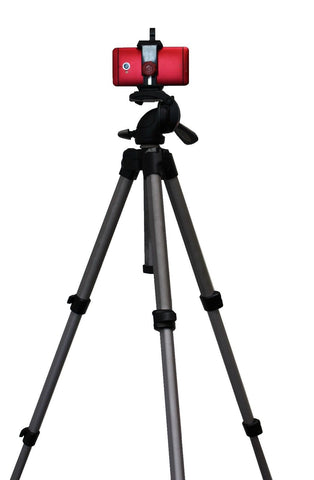"if you were to be jogging while taking a photo, for example, the same shot could well turn out blurred as you and the camera are moving 'far enough' in 1/200th second to cause a blur."
Here in Texas, it's against the law to use a tripod while jogging.
YMMV
Photographers will use a tripod when they want the sharpest image possible. The stability provided by a tripod goes a long way toward this goal.
If you are using a camera with the smallest sensor possible (such as those used in a camera phone), the smallest deviation in steadying the camera will result in larger than average changes in the overall sharpness of the image.
And while you may not notice these less than sharp artifacts when they are displayed on your camera's LCD, if you intend to enlarge and print the images, then the problems existing within the image become enlarged and made more obvious along with the image itself.
Therefore, if all you intend for your photos is to be displayed through social media on other smartphones, then the advantages provided by a tripod will be nill. The limited resolution of a smartphone's LCD will work against showing the effort you have put into the image.
If, however, you intend to enlarge your shots to a printable size of, say, 8x10, then the enlarging process will also demonstrate the advantages of a tripod.
One issue with smartphone cameras is how the shooter operates the camera. If I were using a DSLR with a viewfinder, I would have the camera pressed up against my cheek which provides some degree of stabilization for the lens. My elbows would be in against my body to some degree which will further stabilize the lens. However, when using a camera phone which lacks a viewfinder, you need to assume your normal physical stance for taking a photo and then consider what is wrong with that approach.
When I see someone using their phone camera it is almost always with their arms extended away from their body, never close in with their elbows tucked against their sides as the DSLR shooter would. And never with the advantage of holding the camera against their cheek for added stability.
Obviously, the fewer the points of stability you provide the camera, the greater the chances the camera will shake during the image gathering process. The farther away from those points of stability you move the camera, the greater the chances the image will show some degree of movement.
Yet even the DSLR shooter can be thrown off their game a bit by an unsteady footing or a strong gust of wind. Even the most experienced DSLR shooter would likely defer to using a tripod in either situation.
Most smartphone users would probably simply proceed to take the shot no matter what.
Take the fact of when you might use a tripod and combine it with the very poor grip anyone using a smartphone has on their camera - often a one handed operation - and you have moved as far away from the ideals of a tripod mounted DSLR as possible.
It's a bit like holding a pool cue stick by your fingertips at the smallest end, at arms length and perpendicular to your body and expecting it to remain stable for any length of time.
While faster shutter speeds will tend to minimize the amount of camera shake exhibited in the image, there is nothing better than not allowing camera shake to exist at all. That should be obvious.
As lighting conditions move away from the midday sun ideal and towards less light or less desirable light, the shutter speeds lengthen which provides more and more opportunity for camera shake to affect the image. Even in bright midday sun, if you are shooting into the shadows, it is the shadows which are setting the camera's shutter speeds.
Certainly, given the tremendous differences between indoor and outdoor photography, any photo taken indoors will require much longer shutter speeds which increase the chances of camera shake becoming an issue.
As you can hopefully see, the issue is not with static objects remaining static. It is with the camera not being immovable during the process of gathering the data required to form the digital image. The assumed correct posture for taking a shot with a phone camera goes against all rules intended to provide the stability needed to take the sharpest image possible.
There are though, two arguments against using a tripod with a smartphone camera. The first is what I have mentioned previously, only shooting for display on small, low resolution screens. If your final product will never be displayed on any media which is capable of demonstrating the actual differences between sharp and un-sharp images, then put your money to use elsewhere.
In other words, know your intent before you take the photo. That's fairly good advice for any photographer.
Secondly, setting up a tripod does take some time. While most photographers can benefit from physically interrupting the shoot, shoot, shoot without thought process of taking shapshots, the time involved in setting up a tripod can be an interference in some cases. As mentioned, why would you jog with a tripod? There are certainly better choices of defensive weapons available if it comes to that.
A tripod is simply another tool for the photographer to use. The photographer must decide when it is best put into service and when it is too cumbersome to deal with when shooting in good available light.
The reason photographers use a tripod is simple, they improve your photography.
And, if a tripod is too cumbersome for some situations, guess what? That's why some smart individual took away two of the legs and created a monopod.








![[No title]](/data/xfmg/thumbnail/34/34057-a5a92fad5f5d96a5945d55a404b0cd27.jpg?1734164473)

![[No title]](/data/xfmg/thumbnail/42/42468-f720ff996eb9cc6554c0019901223156.jpg?1734177000)
![[No title]](/data/xfmg/thumbnail/42/42467-e93a2a1ecfbab434ac7d27c9d0dd0a02.jpg?1734176999)

